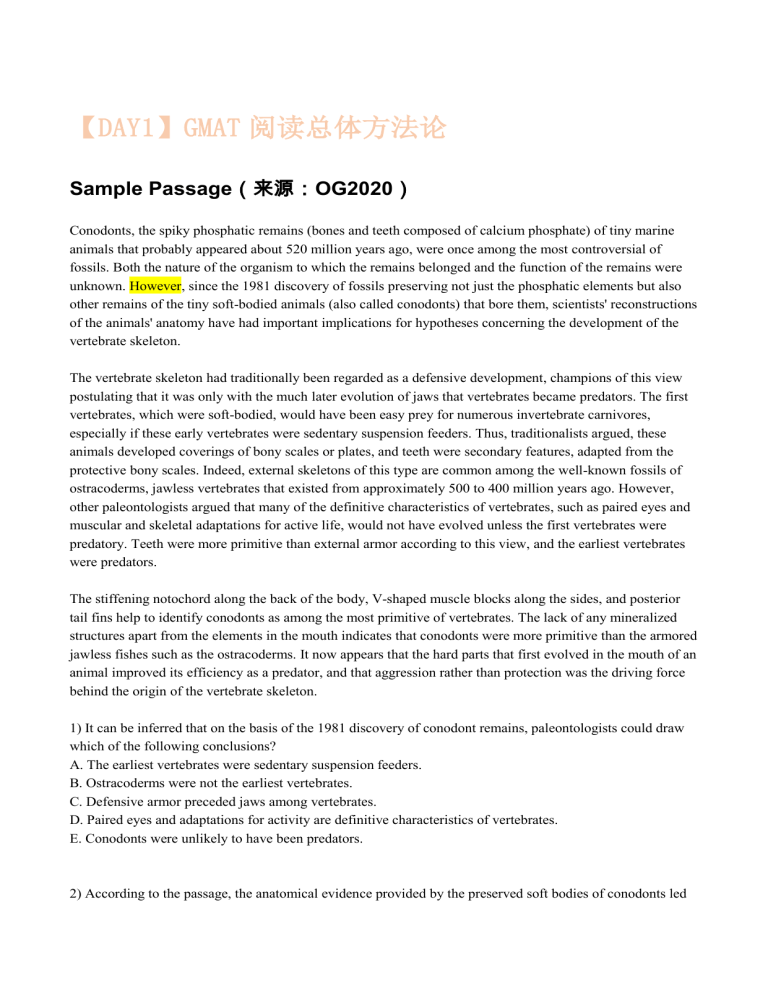
【DAY1】GMAT 阅读总体方法论 Sample Passage(来源:OG2020) Conodonts, the spiky phosphatic remains (bones and teeth composed of calcium phosphate) of tiny marine animals that probably appeared about 520 million years ago, were once among the most controversial of fossils. Both the nature of the organism to which the remains belonged and the function of the remains were unknown. However, since the 1981 discovery of fossils preserving not just the phosphatic elements but also other remains of the tiny soft-bodied animals (also called conodonts) that bore them, scientists' reconstructions of the animals' anatomy have had important implications for hypotheses concerning the development of the vertebrate skeleton. The vertebrate skeleton had traditionally been regarded as a defensive development, champions of this view postulating that it was only with the much later evolution of jaws that vertebrates became predators. The first vertebrates, which were soft-bodied, would have been easy prey for numerous invertebrate carnivores, especially if these early vertebrates were sedentary suspension feeders. Thus, traditionalists argued, these animals developed coverings of bony scales or plates, and teeth were secondary features, adapted from the protective bony scales. Indeed, external skeletons of this type are common among the well-known fossils of ostracoderms, jawless vertebrates that existed from approximately 500 to 400 million years ago. However, other paleontologists argued that many of the definitive characteristics of vertebrates, such as paired eyes and muscular and skeletal adaptations for active life, would not have evolved unless the first vertebrates were predatory. Teeth were more primitive than external armor according to this view, and the earliest vertebrates were predators. The stiffening notochord along the back of the body, V-shaped muscle blocks along the sides, and posterior tail fins help to identify conodonts as among the most primitive of vertebrates. The lack of any mineralized structures apart from the elements in the mouth indicates that conodonts were more primitive than the armored jawless fishes such as the ostracoderms. It now appears that the hard parts that first evolved in the mouth of an animal improved its efficiency as a predator, and that aggression rather than protection was the driving force behind the origin of the vertebrate skeleton. 1) It can be inferred that on the basis of the 1981 discovery of conodont remains, paleontologists could draw which of the following conclusions? A. The earliest vertebrates were sedentary suspension feeders. B. Ostracoderms were not the earliest vertebrates. C. Defensive armor preceded jaws among vertebrates. D. Paired eyes and adaptations for activity are definitive characteristics of vertebrates. E. Conodonts were unlikely to have been predators. 2) According to the passage, the anatomical evidence provided by the preserved soft bodies of conodonts led scientists to conclude that A. conodonts had actually been invertebrate carnivores B. conodonts' teeth were adapted from protective bony scales C. conodonts were primitive vertebrate suspension feeders D. primitive vertebrates with teeth appeared earlier than armored vertebrates E. scientists' original observations concerning the phosphatic remains of conodonts were essentially correct 3) The second paragraph in the passage serves primarily to A. outline the significance of the 1981 discovery of conodont remains to the debate concerning the development of the vertebrate skeleton B. contrast the traditional view of the development of the vertebrate skeleton with a view derived from the 1981 discovery of conodont remains C. contrast the characteristics of the ostracoderms with the characteristics of earlier soft-bodied vertebrates D. explain the importance of the development of teeth among the earliest vertebrate predators E. present the two sides of the debate concerning the development of the vertebrate skeleton Passage 2 For many years, historians thought that the development of capitalism had not faced serious challenges in the United States. Writing in the early twentieth century, Progressive historians sympathized with the battles waged by farmers and small producers against large capitalists in the late nineteenth century, but they did not question the widespread acceptance of laissez-faire (unregulated) capitalism throughout American history. Similarly, Louis Hartz, who sometimes disagreed with the Progressives, argued that Americans accepted laissez-faire capitalism without challenge because they lacked a feudal, precapitalist past. Recently, however, some scholars have argued that even though laissez-faire became the prevailing ethos in nineteen-century America, it was not accepted without struggle. Laissez-faire capitalism, they suggest, clashed with existing religious and communitarian norms that imposed moral constraints on acquisitiveness to protect the weak from the predatory, the strong from corruption, and the entire culture from materialist excess. Buttressed by mercantilist notions that government should be both regulator and promoter of economic activity, these norms persisted long after the American Revolution helped unleash the economic forces that produced capitalism. These scholars argue that even in the late nineteenth century, with the government's role in the economy considerably diminished, laissez-faire had not triumphed completely. Hard times continued to revive popular demands for regulating business and softening the harsh edges of laissez-faire capitalism. 1. The primary purpose of the passage is to A. reveal the underlying similarities of certain arguments regarding the development of capitalism in the United States B. synthesize two competing arguments regarding the development of capitalism in the United States C. defend an established argument regarding the development of capitalism in the United States D. summarize a scholarly refutation of an argument regarding the development of capitalism in the United States E. discuss a new methodology for the study of the development of capitalism in the United States 2. According to the passage, the Progressive historians and the scholars disagree with regard to which of the following? A. Whether laissez-faire became the predominant ethos in the nineteenth-century United States B. Whether moral restraints on acquisitiveness were necessary in the nineteen-century United States C. The economic utility of mercantilist notions of government D. The nature of the historical conditions necessary for the development of laissez-faire capitalism in the nineteen-century United States E. The existence of significant opposition to the development of laissez-faire capitalism in the nineteencentury United States 3. The passage suggests that the scholars would agree with which of the following statements regarding the “norms”? A. They provided a primary source of opposition to the development of laissez-faire capitalism in the United States in the nineteenth century. B. Their appeal was undermined by difficult economic times in the United States at the end of the nineteenth century. C. They disappeared in the United States in the late nineteenth century because of the triumph of laissez-faire capitalism. D. They facilitated the successful implementation of mercantilist notions of government in the United States in the nineteenth-century E. They are now recognized by historians as having been an important part of the ideology of the American Revolution. 【DAY 2】总体方法论练手 请在阅读文章的时候 1. 标注出每句话的逻辑标志词(关系词和观点词),以及让逻辑关系成立的信息; 2. 用一句话总结全文; 3. 做题的时候先根据题干对答案有一个预判。 【答案在最后一页】 Passage 1 Many scholars have theorized that economic development, particularly industrialization and urbanization, contributes to the growth of participatory democracy; according to this theory, it would seem logical that women would both demand and gain suffrage in ever greater numbers whenever economic development expanded their economic opportunities. However, the economic development theory is inadequate to explain certain historical facts about the implementation of women's suffrage. For example, why was women's suffrage, instituted nationally in the United States in 1920, not instituted nationally in Switzerland until the 1970? Industrialization was well advanced in both countries by 1920: over 33 percent of American workers were employed in various industries, as compared to 44 percent of Swiss workers. Granted, Switzerland and the United States diverged in the degree to which the expansion of industry coincided with the degree of urbanization: only 29 percent of the Swiss population lived in cities of 10,000 or more inhabitants by 1920. However, urbanization cannot fully explain women's suffrage. Within the United States prior to 1920, for example, only less urbanized states had granted women suffrage. Similarly, less urbanized countries such as Cambodia and Ghana had voting rights for women long before Switzerland did. It is true that Switzerland's urbanized cantons (political subdivisions) generally enacted women's suffrage legislation earlier than did rural cantons. However, these cantons often shared other characteristics— similar linguistic backgrounds and strong leftist parties—that may help to explain this phenomenon. 笔记: Scholar: 经济(工&城)→ 民主(Suffrage) 作者:经济(工&城)×→ 民主(Suffrage) S:经济发展好但是在 1970 前无民主,但是美国有民主 1920 年 诚然 S 城镇化不好,但是城镇化业不能解释民主。 (Granted,However:让步再转折) 虽然 S 城镇化好的地方有民主,但不是城镇化解释的民主(It is true that, However:让步再转折) 1.The primary purpose of the passage is to A. B. C. D. E. contrast two explanations for the implementation of women's suffrage demonstrate that one factor contributes more than another factor to the implementation of women's suffrage discuss the applicability of a theory for explaining the implementation of women's suffrage clarify certain assumptions underlying a particular theory about the implementation of women's suffrage explain how a particular historical occurrence was causally connected to the implementation of women's suffrage 2.According to the passage, the scholars mentioned in the highlighted text assert which of the following about the growth of participatory democracy within a particular nation? A. B. C. D. It is not necessarily correlated with increasing income and opportunities for women in that nation. It is not necessarily related to the implementation of women's suffrage within that nation. It cannot adequately explain the nation's level of economic development. It tends to be encouraged by the occurrence of industrialization in that nation. E. It is to increase with the growth of leftist parties in that nation. 3.The passage suggests which of the following about states in the United States prior to 1920? A. The states that were not highly urbanized were slow to grant women's suffrage. B. The states that were highly urbanized were the most influential in determining national policies regarding suffrage. C. The most highly urbanized states were more likely to have strong leftist parties. D. The most highly urbanized states were not necessarily the most industrialized ones. E. The most highly urbanized states had not yet granted women's suffrage. 4.The passage states which of the following about Switzerland's urbanized cantons? A. These cantons shared characteristics other than urbanization that may have contributed to their implementation of women's suffrage. B. These cantons tended to be more politically divided than were rural cantons. C. These cantons shared with certain rural cantons characteristics such as similar linguistic backgrounds and strong leftist parties. D. The populations of these cantons shared similar views because urbanization furthered the diffusion of ideas among them. E. These cantons were comparable to the most highly urbanized states in the United States in their stance toward the implementation of women's suffrage. 5.The passage suggests which of the following about urbanization in Switzerland and the United States by 1920? A. A greater percentage of Swiss industrial workers than American industrial workers lived in urban areas. B. There were more cities of 10,000 or more inhabitants in Switzerland than there were in the United States. C. Swiss workers living in urban areas were more likely to be employed in industry than were American workers living in urban areas. D. Urbanized areas of Switzerland were more likely than similar areas in the United States to have strong leftist parties. E. A greater percentage of the United States population than the Swiss population lived in urban areas. Passage 2 In 1994, a team of scientists led by David Mckay began studying the meteorite ALH84001, which had been discovered in Antarctica in 1984. Two years later, the McKay team announced that ALH84001, which scientists generally agree originated on Mars, contained compelling evidence that life once existed on Mars. This evidence includes the discovery of organic molecules in ALH84001, the first ever found in Martian rock. Organic molecules—complex, carbon based compounds—form the basis for terrestrial life. The organic molecules found in ALH84001 are polycyclic aromatic hydrocarbons, or PAH’s. When microbes die, their organic material often decays into PAH’s. Skepticism about the McKay team’s claim remains, however. For example, ALH84001 has been on earth for 13,000 years, suggesting to some scientists that its PAH’s might have resulted form terrestrial contamination. However, McKay’s team has demonstrated that the concentration of PAH’s increases as one looks deeper into ALH84001, contrary to what one would expect from terrestrial contamination. The skeptic’s strongest argument, however, is that processes unrelated to organic life can easily produce all the evidence found by McKay’ s team, including PAH’s. For example, star formation produces PAH’s. Moreover, PAH’s frequently appear in other meteorites, and no one attributes their presence to life processes. Yet McKay’s team notes that the particular combination of PAH’s in ALH84001 is more similar to the combinations produced by decaying organisms than to those originating form nonbiological processes. 1. The passage asserts which of the following about the claim that ALH84001 originated on Mars? A. It was initially proposed by the McKay team of scientists. B. It is not a matter of widespread scientific dispute. C. It has been questioned by some skeptics of the McKay team’s work. D.I t has been undermined by recent work on PAH’s. E. It is incompatible with the face that ALH84001 has been on Earth for 13,000 years. 2. The passage suggests that the fact that ALH84001 has been on earth for 13,000 years has been used by some scientists to support which of the following claims about ALH84001? A. ALH84001 may not have originated on Mars. B. ALH84001 contains PAH’s that are the result of nonbiological processes. C. ALH84001 may not have contained PAH’s when it landed on Earth. D. The organic molecules found in ALH84001 are not PAH’s. E. The organic molecules found in ALH84001 could not be the result of terrestrial contamination. Passage 3 A recent study has provided clues to predator-prey dynamics in the late Pleistocene era. Researchers compared the number of tooth fractures in present-day carnivores with tooth fractures in carnivores that lived 36,000 to 10,000 years ago and that were preserved in the Rancho La Brea tar pits in Los Angeles. The breakage frequencies in the extinct species were strikingly higher than those in the present-day species. In considering possible explanations for this finding, the researchers dismissed demographic bias because older individuals were not overrepresented in the fossil samples. They rejected preservational bias because a total absence of breakage in two extinct species demonstrated that the fractures were not the result of abrasion within the pits. They ruled out local bias because breakage data obtained from other Pleistocene sites were similar to the La Brea data. The explanation they consider most plausible is behavioral differences between extinct and present-day carnivores--in particular, more contact between the teeth of predators and the bones of prey due to more thorough consumption of carcasses by the extinct species. Such thorough carcass consumption implies to the researchers either that prey availability was low, at least seasonally, or that there was intense competition over kills and a high rate of carcass theft due to relatively high predator densities. 1. The passage suggests that, compared with Pleistocene carnivores in other areas, Pleistocene carnivores in the La Brea area (A) included the same species, in approximately the same proportions (B) had a similar frequency of tooth fractures (C) populated the La Brea area more densely (D) consumed their prey more thoroughly (E) found it harder to obtain sufficient prey 2. The passage suggests that tooth fractures in Pleistocene carnivores probably tended to occur less frequently (A) during periods in which more prey were available (B) at sites distant from the La Brea area (C) in older individual carnivores (D) in species that were not preserved as fossils (E) in species that regularly stole carcasses from other species




